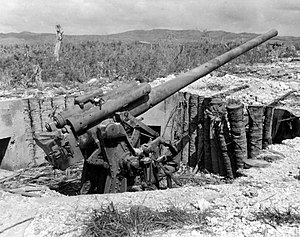Type 10 120 mm AA gun
| Type 10 120 mm dual-purpose gun | |
|---|---|
 A damaged dual purpose 120 mm gun from a four gun battery on Guam. | |
| Type | Dual-purpose gun |
| Place of origin | Japan |
| Service history | |
| In service | 1921-1945 |
| Used by |  Empire of Japan Empire of Japan |
| Wars | Second World War |
| Production history | |
| Produced | 1921-1945 |
| No. built | approx 2000 |
| Specifications | |
| Mass | 8.5 tons |
| Length | 5.94 m (19 ft 6 in) |
| Barrel length | 5.4 m (17 ft 9 in) L/45 |
| Width | 2.16 m (7 ft 1 in) |
| Height | 2.34 m (7 ft 8 in) |
| Shell | Fixed QF ammunition 120 x 708R |
| Shell weight | 20.6 kg (45 lb 7 oz) |
| Caliber | 120 mm (4.7 in) |
| Action | Semi-automatic |
| Breech | Horizontal sliding-wedge |
| Recoil | Hydro-spring |
| Carriage | Pedestal mount |
| Elevation | -5 to +75 degrees |
| Traverse | 360 degrees |
| Rate of fire | 10 to 12 rounds per minute |
| Muzzle velocity | 825 m/s (2,710 ft/s) |
| Effective firing range | Horizontal: 16,000 m (17,000 yd) Vertical: 8,500 m (27,900 ft) |
| Maximum firing range | Vertical: 10,000 m (33,000 ft) |
The Type 10 or 12 cm/45 10th Year Type naval gun was a Japanese 120 mm calibre dual purpose anti-aircraft and coastal defense gun used during the Second World War. It was derived from the 12 cm/45 3rd Year Type naval gun. The Type 10 number was designated for the year the gun was accepted, the 10th year of Emperor Taishō's reign, 1927 in the Gregorian calendar.[1] It served as the secondary armament on a number of Japanese aircraft carriers and cruisers and as the main armament on smaller ships, in single or twin mountings.[2]
Description
The weapon was originally designed for ship use and was produced in large numbers during 1944. The gun was also adapted for land use as a dual-purpose gun. The barrel was of autofretted mono-block construction and was held in a sleeve cradle mounted on a pedestal mount which permits 360° of traverse. The gun uses a hydro-spring recoil mechanism attached to the sleeve cradle and there are three recoil cylinders located on top of the breech with the two outside cylinders housing the recoil springs, and the center cylinder housing the hydraulic recuperator.[1] The elevating handwheel is on the right side of the mount, while the traversing handwheel is on the left. To compensate for muzzle preponderance, spring equilibrators are mounted below the gun barrel. The gun is said to be well balanced, and easy to elevate. A semi-automatic horizontal sliding-wedge breech is used and Fixed QF 120 x 708R ammunition was used. The gun fired either high explosive or incendiary shrapnel shells that weighed 20.6 kg (45 lb 7 oz), with a complete round weighing 32.4 kg (71 lb 7 oz).[3]
- Aoba-class cruiser
- Furutaka-class cruiser
- Takao-class cruiser
- Taiyō-class escort carrier
- Japanese munition ship Kashino
- Escort vessels and auxiliary vessels[2]
See also
Weapons of comparable role, performance and era
- QF 4.7 inch Mk VIII naval gun : British equivalent naval anti-aircraft gun
References
- ^ a b War Department TM-E-30-480 Handbook on Japanese Military Forces September 1944 p 400
- ^ Campbell, Naval Weapons of WWII, p.194-95.
Bibliography
- War Department TM-E-30-480 Handbook on Japanese Military Forces September 1944
- Campbell, John (1985). Naval Weapons of World War II. Annapolis, Maryland: Naval Institute Press. ISBN 0-87021-459-4.
External links

- 12 cm/45 10th Year Type on navweaps.com
- v
- t
- e
 Imperial Japanese Army artillery
Imperial Japanese Army artillery- 28 cm howitzer
- Type 41 8 cm coast defense gun
- Type 11 12 cm coast defense gun
- Type 3 12 cm coast defense gun
- Type 41 15 cm/40 coast defense gun
- Type 41 15 cm/45 coast defense gun
- Type 41 15 cm/50 coast defense gun
- Type 45 15 cm cannon
- Type 41 12 cm coast defense gun
- Type 3 14 cm coast defense gun
- Type 41 20 cm coast defense gun
- Type 89 127 mm dual purpose gun
- Type 10 12 cm dual purpose gun
- Type 3 8 cm dual purpose gun
- Type 98 10 cm dual purpose gun
- 25 cm artillery mortar
- 70 mm barrage mortar
- Type 11 70 mm infantry mortar
- Type 2 12 cm mortar
- Type 3 81 mm mortar
- Type 93 150 mm infantry mortar
- Type 94 90 mm infantry mortar
- Type 95 15 cm mortar
- Type 96 and Type 97 150 mm infantry mortar
- Type 97 81 mm infantry mortar
- Type 97 90 mm infantry mortar
- Type 98 320 mm mortar
- Type 98 50 mm mortar
- Type 99 81 mm mortar
- 7 cm mountain gun
- Type 31 75 mm mountain gun
- Type 41 75 mm mountain gun
- Type 94 75 mm mountain gun
- Type 99 10 cm mountain gun
 | This article relating to artillery is a stub. You can help Wikipedia by expanding it. |
- v
- t
- e











